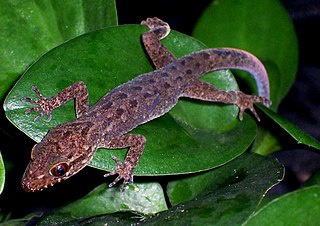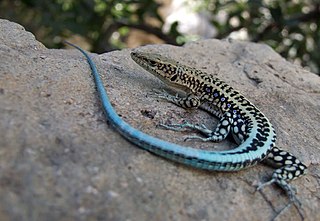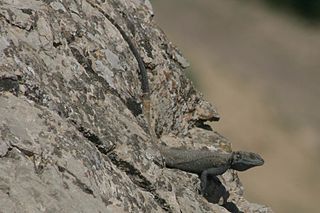
The Lacertidae are the family of the wall lizards, true lizards, or sometimes simply lacertas, which are native to Afro-Eurasia. It is a diverse family with at about 360 species in 39 genera. They represent the dominant group of reptiles found in Europe.

Cyrtodactylus is a diverse genus of Asian geckos, commonly known as bent-toed geckos, bow-fingered geckos, and forest geckos. The genus has 361 described species as of 2024, which makes it the largest of all gecko genera.

Leiocephalidae, also known as the curlytail lizards or curly-tailed lizards, is a family of iguanian lizards restricted to the West Indies. One of the defining features of these lizards is that their tail often curls over. They were previously regarded as members of the subfamily Leiocephalinae within the family Tropiduridae. There are presently 30 known species, all in the genus Leiocephalus.

The thorny devil, also known commonly as the mountain devil, thorny lizard, thorny dragon, and moloch, is a species of lizard in the family Agamidae. The species is endemic to Australia. It is the sole species in the genus Moloch. It grows up to 21 cm (8.3 in) in total length, with females generally larger than males.
Liushusaurus is an extinct genus of lizard described by Susan E. Evans and Yuan Wang in 2010. The genus has a single species, Liushusaurus acanthocaudata, and is known from eight fossils, several of which preserve soft tissue detail. The specimens were found in the Lower Cretaceous aged Yixian Formation of Northeast China. Liushusaurus is one of eight lizards that are known and have been named from the Yixian Formation, part of the diverse Jehol Biota ecosystem.

Phrynocephalus persicus, commonly known as the Persian toad-headed agama, is a small diurnal desert lizard of the family Agamidae. It is the westernmost representative of the Central Asian genus of toad-headed agamas Phrynocephalus and is only known from deserts and semideserts of Iran and possibly Azerbaijan.
Acanthodactylus nilsoni, commonly called Nilson's spiny-toed lizard, is a species of lizard in the family Lacertidae. The species is endemic to Iran.
Parsigecko is a monotypic genus of lizards in the family Gekkonidae. It contains one species, Parsigecko ziaiei, known as Ziaie's Pars-gecko. It is found in southern Iran.
Apathya yassujica, the Yassujian lizard, is a species of lizard endemic to Iran.

The Anatolian lizard is a species of lizard endemic to Iran, Iraq, Syria and Turkey.

Eremias persica, the Aralo-Caspian racerunner or Persian racerunner, is a species of lizard native to Iranian Azerbaijan, most of Iran, southern Turkmenistan, Afghanistan, and western Pakistan. Eremias intermedia is also known as the Aralo-Caspian racerunner.
Iranolacerta zagrosica, also known commonly as the Zagros Mountains lacerta, is a species of lizard in the family Lacertidae. The species is endemic to Iran.
Asaccus andersoni is a species of leaf-toed gecko endemic to Iran, on the western slopes of the central Zagros Mountains. It lives in on rocks in gullies of mountainous oak forests. It is named in honor of Steven Clement Anderson, in recognition of "his major contributions to the knowledge of the herpetofauna of the Middle East and the Iranian Plateau in particular".

Asaccus granularis is a species of leaf-toed gecko endemic to Iran. The specific epithet refers to the granular scales on the back of this lizard. It is only known from the type locality in Lorestan Province, Iran. It was found in a mountainous area with open oak forests, on rocky outcrops and under large boulders.
The Kermanshah leaf-toed gecko is a species of gecko endemic to Iran. It is named for the type locality, north of Kermanshah, eastern Kermanshah Province, in the Zagros Mountains of western Iran. It is found in caves and rock crevices at 1,400 m (4,600 ft).

Asaccus nasrullahi, Nasrullah's leaf-toed gecko, is a species of gecko in the family Phyllodactylidae. The species is endemic to Iran. The specific name nasrullahi was chosen in honor of Iranian herpetologist Nasrullah Rastegar-Pouyani, "in recognition of his contribution to the knowledge of the herpetology of Iran, including the genus Asaccus".
Asaccus tangestanensis is a species of leaf-toed gecko endemic to Iran. This gecko is found in the southern Zagros Mountains in Bushehr Province. It is found in cliffs and caves. The holotype was collected in 2008 and the species is named for Tangestan, the type locality.
Asaccus zagrosicus is a species of leaf-toed gecko endemic to Iran. The holotype was collected in 2008 in southern Lorestan in the Tang-e-Haft Region between the central Zagros Mountains and Khuzestan Plain.

The Persian snake skink is a species of skink endemic to Iran. A specimen collected in 1999 was found on sandy clay soil near Artemisia shrubs. It was originally described in 1867 as Hemipodion persicum.

Laudakia nupta is a species of lizard from Iraq, Iran, Afghanistan, and Pakistan. It was described in 1843. There are two subspecies, Laudakia nupta nupta and Laudakia nupta fusca.











